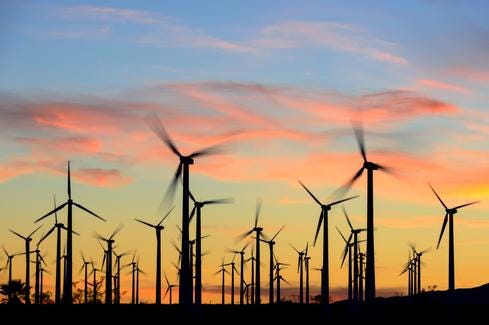Ohio Wind Farms: A Blustery Debate
BY NICK ROGERS
CHARDON - With the Biden/Harris administration’s goal of “decarbonizing” the U.S. electrical grid by 2035, the push is on for “renewable” energy options such as solar and wind. The “public utility exemption” has long-since paved the way for the ongoing buildout of electrical grid infrastructure, regardless of the wishes of local residents or politicians, but the 2021 passing of HB 52 has placed an obstacle in the way of wind farm projects, granting county commissioners greater power to approve or deny new projects. This has spurned a contentious battle between energy companies, local authorities, and residents; a debate ranging from aesthetics to feasibility to health.

“As soon as Senate Bill 52 passed, the anti-wind people, they started converging on our weekly commissioners’ meetings and demanding that we do something,” said Doug Weisenauer of the Crawford County Commission. The commission voted 2-1 for a ten year ban on wind farm development, and the vote was upheld in a subsequent referendum.
Columbia Law School’s Sabin Center for Climate Change stated in a report, “…in nearly every state, local governments have enacted policies to block or restrict renewable energy facilities and local opposition has resulted in the delay or cancellation of particular projects.” According to the National Renewable Energy Laboratory, almost 2,000 wind energy ordinances have been enacted in this country.
But why the intense opposition? “Not in my backyard” is a mantra that echoes frequently in this debate, though possibly the more appropriate phrase would be “Not in my neighbor’s back yard.” Some opponents of wind farms believe the infrastructure negatively affects human and animal health, be it on their own property or not.
While local governments have been lured into considering wind farm development through lucrative tax incentives, people like Crawford County’s Bob Sostakowski assert that wind farms negatively affect adjacent property values. “There’s an obvious and very provable negative impact on property values and people’s standard of living,” Sostakowski said.
Seneca County’s Kimberly Groth said, “People want quality of life and people move to rural areas because of the peacefulness of it. When you introduce industrial scale wind over tens of thousands of acres, you’re interrupting that quality of life.” Groth added, “I think we’ve heard for 20 to 30 years now about renewable energy and there’s just this assumption that it’s good and that it’s going to save us. The more I looked into it, the more I realized it does have downsides.”
Those downsides include bird/bat fatalities, disrupted horizon views, and potential health impacts on humans living nearby; and the complaints reach far beyond Ohio. Dona Kearny, a Stonestown Ireland resident, said, “Some nights the noise from the turbines is brutal. It’s keeping us awake and we are not getting a proper sleep. Our experience of the farm has been negative from day one.” Some anti-wind activists claim that inaudible “infrasound” can cause sleep deprivation, memory loss, and vertigo, among other symptoms.
“Shadow flicker” has been reported more and more frequently for those living near wind farms, though there are those who say it’s a non-issue. Mike Brady of Paulding County said, “There is flicker at my house. It’ll maybe last five minutes. It just depends on the wind and the angle of the sun. We pull our drapes.” Regarding the noise coming from the turbines, he said, “You can hear a hum out of them. But it doesn’t keep you awake.”
And despite anecdotal evidence from doctors who claim their patients are experiencing multiple ailments as a result of wind farms being erected nearby, the “clean energy” industry and the Ohio Department of Health (ODH) – as well as those in mainstream media – have been quick to debunk “Wind Turbine Syndrome” as “psychosomatic” and fear-based. ODH’s 2022 report of purported wind farm-induced ailments declared, “…this syndrome is not a clinically recognized diagnosis and is not generally accepted by the scientific and medical community to date.”
Proponents of wind farm development, like former Paulding County Commissioner Tony Zartman, highlight large government subsidies which have benefited financially struggling communities. Zartman points out that, before wind turbine farms came to his area, the county was “…virtually bankrupt,” hit hard like so many rural areas by the 2007 recession. A vast improvement, he says, has taken place. Brady said of local schools, “All the school districts struggled with money. Now they’re doing quite well.”
Many struggling farmers are eager to lease their land for wind farm projects and believe it should be up to them to decide what can or can’t be erected on their own land.
Anne Frye, a retired school teacher living on 300 acres, was excited about leasing her land for wind farm use, and she was distraught to find out that a November 2021 Commissioner vote banned large wind and solar implementation in the county’s unincorporated areas. “It’s our land,” Frye said. “And if we want to grow corn, soybeans, or put green energy on our land, why is it someone else’s choice, who might live on a postage stamp size lot, to tell us what we can and cannot do with our land?”
Dave Crum, a resident of Crawford County with a lease for Apex Energy’s blocked Honey Creek project said, “I can’t understand the difference between renting your land for crop land and renting your land for a wind turbine. It’s baffling when you have things that you think will help the community and they don’t let it happen.” According to Apex Energy, the Honey Creek wind farm would provide $2.7 million annually for schools and government services.
Brian O’Shea, a spokesman for Apex Energy, warned that the vote “…embodies a dangerous precedent-setting expansion of government authority over local property rights.”
And then there’s the nuts and bolts discussion of the actual physical feasibility/reliability/necessity of wind farms. According to
http://www.wind-watch.org/
, wind turbines generate very little energy when wind speeds dip below 30mph. The site states, “Wind turbines produce at or above their average rate around 40% of the time. Conversely, they produce little or no power around 60% of the time. 50% of the time, they produce at a rate about two-thirds their average.”
According to a projection from the U.S. Energy Information Administration (EIA), only 1% of the country’s electricity will be produced by wind by 2023. President of the National Wind Watch Eric Rosenbloom – also author of A Problem With Wind Power – emphatically stated, “It is obvious — even in the EIA’s very hopeful scenario — that wind will never be an important part of electricity production.” He added, “That is not to endorse any other source as problem free. It is simply facing the fact that wind is not a viable alternative.”
The need for “clean,” “renewable” energy rests on the fundamental foundation of mainstream science’s consensus that “climate change” is not only a real problem, but a dire one, and that it relates primarily to carbon dioxide emissions. The IPCC “Climate Gate” email hacks poked a large whole in this consensus, and the PR recovery backlash has predictably been fierce, with “climate change deniers” finding themselves in the crosshairs.
A document that supposedly contains 1,609 scientific signatories declaring that “There is no climate emergency” has been vehemently “debunked” in mainstream media. And, all the while, these points and counterpoints tend to always take place outside of the conversation of possible large-scale geoengineering operations happening in the skies above; the reason, many claim (including this author), behind the growing number of droughts, deluge, and other disastrous whether events around the globe.
The Ohio wind farm debate has many variables and facets, and each side of the argument has made viable points; most of which, unsurprisingly, relate to personal interest and agendas.
Though HB 52 stands as a big win for anti-wind farm activists, the Ohio Supreme Court recently wielded its power in favor of the industry and its proposed Emerson Creek Project. With the UN’s Agenda 2030 and its “clean energy” plan – along with their “net zero” emission goals – it’s clear that wind farms in Ohio and beyond will continue to be pushed upon the people whether they want them or not. Do you want them?




